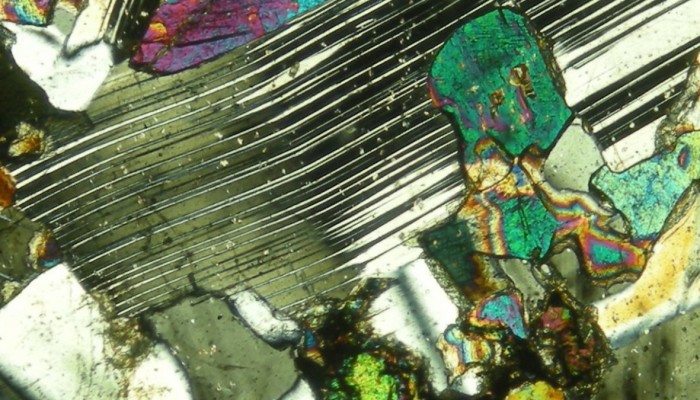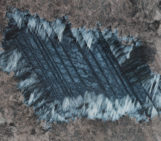
The impressive Zagros Orogeny, as seen from a bird’s-eye view, has featured on Imaggeo on Monday’s blog posts a few times recently. From its fluvial dissection features, through to a false colour LANDSAT 7 image which reveals a velociraptor hiding among fold and thrusts, we’ve looked at the broad scale structures which shape the Zagros mountains. This week, the scale changes entirely: we zoom right into the fabric of the Zagros Mountains rocks, as shown by the minerals in a thin section. Despite the close-up and small-scale view thin sections offer, they can still reveal huge amounts of information about the past history of rocks.
The thin section image above, taken by Amirhossein Mojtahedzadeh, a member of the Geological Society of Iran, is from the northwestern part of the Zagros mountain belt, which spans Kurdistan (in northwester Iran). Here, the mountains have suffered multiple stages of metamorphism and deformation, as evidenced by the large twinned plagioclase (the stripped white and black mineral which dominates the image) in the centre of the view. Plagiocalse is a common rock-forming mineral of the silicate family. Amongst their many properties, plagioclase crystals commonly form twins, which essentially means that a single crystal of a mineral has two or more parts in which the crystal lattice is differently orientated (which is explained in full detail in this great blog post by former EGU network bloggers, Between a Rock and a Hard Place). This property of plagioclases is an important tool in petrological analysis as it usually results from a change in the conditions while the mineral is forming, hinting at larger scale changes in the rock‘s environment, such as an increase in the local environments pressure or temperature, for example.
The rock in the thin section above, is a metamorphosed olivine gabbro – typically formed in igneous environments – except that the plagioclases reveal tell-tale signs that this particular specimen has been reheated or buried, perhaps even both, after if formed. Local strain in the rocks results in the twinned crystals having a lenticular shape. Plastic deformation (meaning the crystal will never go back to the shape it was originally) driven by situations of intense temperature and pressure, causes atomic layers in minerals to slide past each other without friction and thus changes the orientation of twins. Whilst studying the rock, Amirhossein found that sometimes these conditions made elongated aggregates and led to the minerals gaining a new crystal structure.
Imaggeo is the EGU’s online open access geosciences image repository. All geoscientists (and others) can submit their photographs and videos to this repository and, since it is open access, these images can be used for free by scientists for their presentations or publications, by educators and the general public, and some images can even be used freely for commercial purposes. Photographers also retain full rights of use, as Imaggeo images are licensed and distributed by the EGU under a Creative Commons licence. Submit your photos at http://imaggeo.egu.eu/upload/.
###
Edit (26/10/2015): Following comments by Graham Cunningham on Facebook, this text was improved by substituting silicon family to silicate family in the sentence: Plagiocalse is a common rock-forming mineral of the silicate family.



